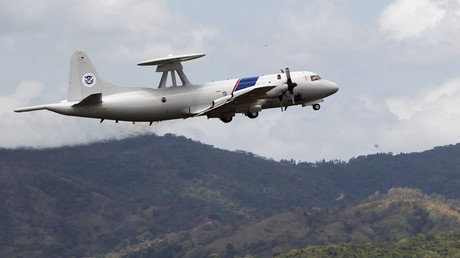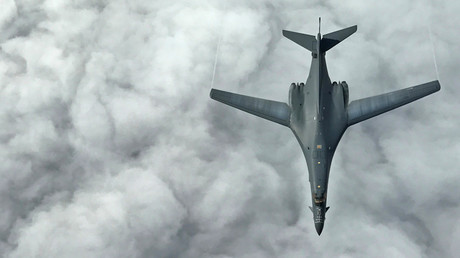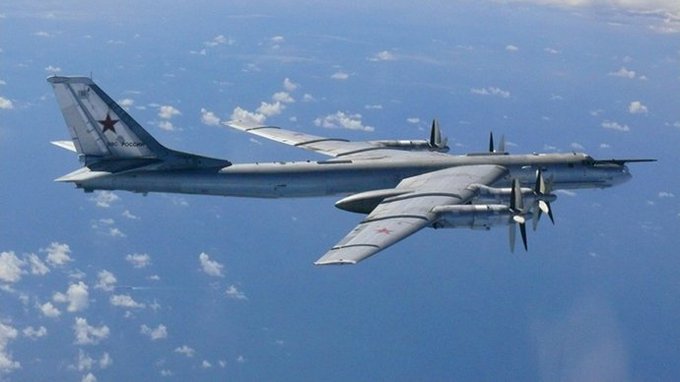Armed Chinese jets drive off US spy plane over Yellow Sea

A US spy plane flying near the eastern coast of China was intercepted by two Chinese fighter jets and had to change course, US officials said. The surveillance aircraft was flying over international waters between China and South Korea.
The incident took place on Sunday, unnamed US officials told reporters on Monday. An EP-3 ARIES signals intelligence plane was flying about 90 miles (140km) south of the port city of Qingdao, when it was approached by two J-10 interceptors, armed with air-to-air missiles.
One of the Chinese jets flew under the EP-3 and popped up 300 feet (90 meters) in front of the US plane, causing the crew “to take evasive action to avoid collision,” according to one official.
The US Navy described the flight as “a routine mission operating in accordance with international law” up until the “interaction” between the spy plane and the Chinese interceptors.
“While we are still investigating the incident, initial reports from the US aircrew characterized the intercept as unsafe,” said Lieutenant-Commander Matt Knight, Pacific Fleet spokesman. “The issue is being addressed with China through appropriate diplomatic and military channels.”
The EP-3 Airborne Reconnaissance Integrated Electronic System (ARIES) is a version of the P-3 Orion spy plane. Both are in service with the US Navy.
The US armed forces have recently stepped up their activity in the region, provoking anger in China. In early July, Beijing accused Washington of violating China’s sovereignty and international law after a US missile destroyer sailed some 30 kilometers from the disputed Paracel Islands in the South China Sea with Beijing sending warplanes and military vessels to intercept the ship.
Besides China, which claims practically all of the South China Sea, Brunei, Malaysia, the Philippines, Taiwan and Vietnam lay conflicting claims to the islands.
This is the third time in recent months that Chinese interceptors have warned off US spy planes flying off the coast of China. In late May, as the US Navy sailed near disputed islands in the South China Sea, two Chinese jets buzzed a P-3 Orion 150 miles (240km) southeast of Hong Kong in what US officials called an “unsafe intercept.”
A week earlier, Chinese jets intercepted a US Air Force WC-135 Constant Phoenix “nuclear sniffer” plane over the East China Sea.
In April 2001, an EP-3E ARIES II collided with a Chinese J-8 fighter and had to make an emergency landing on Hainan Island. The crash killed the Chinese pilot. While the crew was repatriated within 10 days, the plane remained in Chinese possession until July, when it was shipped back to the US in pieces.
China previously slammed the US for citing freedom of navigation and overflight as pretexts to show off its military force. Following the overflight of the two US B-1B Lancer bombers over the disputed waterway last month, the Chinese Foreign Ministry said that China “resolutely opposes”provocations carried out in the name of exercising this freedom that are designed to “flaunt military force and harm China’s sovereignty and security.”
Washington, however, is no stranger to accusing other nations of “provocations” when a foreign aircraft appears in international airspace close to the US border. In May, a group of Russian Tu-95 “Bear” bombers and Su-35 jets were intercepted by US Air Force during a “routine flight over international Pacific waters” off the coast of Alaska.
The incident immediately made the headlines in the US media. Fox News broke this story by saying that the aircraft “entered Alaska’s Air Defense Zone” and “prompted Air Force escort.” It also referred to the routine Russian flights near Alaska as “recent Russian provocations.”
When it comes to own jets approaching non-NATO states, the US has been known to lash out at intercepts, which it often deems to be carried out improperly.
On June 21, the United States European Command (EUCOM) expressed its concern over the Russian Su-27 jet intercepting a NATO F-16 fighter jet over the Baltic Sea by describing the incident as “unsafe.” However, it was the NATO aircraft that approached a Russian defense minister’s plane above the neutral waters of the Baltic Sea thus provoking a response from the plane’s military escort.
Just a day earlier, a spokesman for the US European Command, Navy Capt. Danny Hernandez, accused the Russian pilot of having “poor control of the aircraft” during another incident, involving the Russian and US planes. The Russian Defense Ministry responded that it was the US RC-135 spy plane that approached the Russian border and then made a “provocative turn” towards the Russian fighter jet, which had been scrambled for an interception mission.



No comments:
Post a Comment
Comments always welcome!